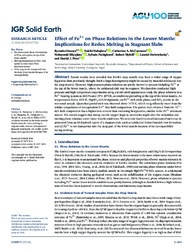Effect of Fe3+ on Phase Relations in the Lower Mantle: Implications for Redox Melting in Stagnant Slabs
Petitgirard, Sylvain
Dubrovinsky, Leonid
DOI: https://doi.org/10.1029/2019JB017704
Persistent URL: http://resolver.sub.uni-goettingen.de/purl?gldocs-11858/9485
Persistent URL: http://resolver.sub.uni-goettingen.de/purl?gldocs-11858/9485
Sinmyo, Ryosuke; Nakajima, Yoichi; McCammon, Catherine A.; Miyajima, Nobuyoshi; Petitgirard, Sylvain; Myhill, Robert; Dubrovinsky, Leonid; Frost, Daniel J., 2019: Effect of Fe3+ on Phase Relations in the Lower Mantle: Implications for Redox Melting in Stagnant Slabs. In: Journal of Geophysical Research: Solid Earth, Band 124, 12: 12484 - 12497, DOI: 10.1029/2019JB017704.
 |
Dokument öffnen: |
Recent studies have revealed that Earth's deep mantle may have a wider range of oxygen fugacities than previously thought. Such a large heterogeneity might be caused by material subducted into the deep mantle. However, high-pressure phase relations are poorly known in systems including Fe3+ at the top of the lower mantle, where the subducted slab may be stagnant. We therefore conducted high-pressure and high-temperature experiments using a multi-anvil apparatus to study the phase relations in a Fe3+-bearing system at 26 GPa and 1573–2073 K, at conditions prevailing at the top of the lower mantle. At temperatures below 1923 K, MgSiO3-rich bridgmanite, an Fe3+-rich oxide phase, and SiO2 coexist in the recovered sample. Quenched partial melt was observed above 1973 K, which is significantly lower than the solidus temperature of an equivalent Fe3+-free bulk composition. The partial melt obtained from the Fe3+-rich bulk composition has a higher iron content than coexisting bridgmanite, similar to the Fe2+-dominant system. The results suggest that strong mantle oxygen fugacity anomalies might alter the subsolidus and melting phase relations under lower mantle conditions. We conclude that (1) a small amount of melt may be generated from an Al-depleted region of a stagnant slab, such as subducted former banded-iron-formation, and (2) Fe3+ is not transported into the deep part of the lower mantle because of its incompatibility during melting.
Statistik:
ZugriffsstatistikSammlung:
This is an open access article under the terms of the Creative Commons Attribution License, which permits use, distribution and reproduction in any medium, provided the original work is properly cited.

